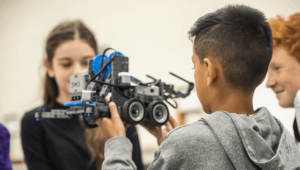To Innovate in Education, First Standardize

Standardization harms students. The much-maligned industrial model of education truly is flawed in countless ways that flow from the assumption that children are like interchangeable parts on an assembly line:
- Humans learn at different rates, yet our system of education requires that students be taught in lock-step according to their age. At any given time, in any given classroom, some students are too bored with the slow pace to be able to stay focused and some are too overwhelmed, stressed, discouraged, or “behind” to take in new learning. Any of these students sitting down with a personal tutor would learn far more at their own pace, but there are nowhere near enough resources to make that possible. As a result, the very structure of schooling drives disengagement (though excellent teachers can and do help learners by going the extra mile every day to overcome this flawed structure.)
- Humans have different interests and learn in different ways, yet our system of education requires that students be taught according to adopted curricula. These curricula are increasingly “teacher-proofed” and reduce the degrees of freedom an educator has in supporting a given student where he or she is at a given time. Worse, “scripted” curricula (in combination with high stakes tests) have the side effect of rewarding the lowest common denominator of teaching and filtering out, or making invisible, all the things that really good teachers do to help each individual, unique student be ready to learn whatever is next.
- Human learning is most authentic when it is active, when it is social, when it involves doing, but our culture still largely considers a quiet classroom with students in rows, working individually and not cheating by discussing their work to be the ideal. The industrial model of education eschews authenticity in favor of superficial conformity. Counterexamples to this sort of learning have long been available, as with Montessori schools, and are becoming increasingly wide-spread, as with problem or project based learning. Unfortunately, although excellent examples of authentic learning exist, at scale the culture of industrial-model schooling generally bends and reshapes these authentic practices into bloodless simulacra that mimic authentic practices but focus on the “assessable” outcome rather than the process, depriving students of real inquiry, real exploration, and real learning.
Students are not cogs in a machine. Neither are they Skinnerian box-dwellers to be motivated by carrots and sticks. Nurturing learners is the opposite of performing quality control on human worth. Standardized school days, curriculum, learning periods, behavior, and high stakes tests all steal our children’s opportunities for the genuine, shared and engaging struggle that comprises the sort of real learning that we all must engage in for meaningful life and work in this century. No wonder there is such an outcry against standardization in education and a backlash against the organizations, corporations, and foundations that pursue it.
However.
Although there is much bad standardization in education, this doesn’t mean that standardization has no place. There is something to be learned about standardization from the high tech industry – the question is not whether to standardize, but rather where and how.
In high tech, standardization enables explosive innovation. For example, the IP protocol is a standard that allows all devices to communicate over the Internet in the same way. This means that web sites, apps, and services don’t have to spend all the resources necessary to build their own communications standards. Further, it means that all these sites, apps, and services that were created by different groups have the ability to communicate with each other. By standardizing infrastructure, the web 2.0 environment created such a low barrier of entry to anyone building new apps and services, and such generative complexity that the interaction of engineers, users, communities, and commercial entities with an ever-growing universe of software profoundly changed many aspects of our lives and work. The key was to standardize well, at the correct level, in order to allow innovation to flourish higher up the stack.
Education is not the Internet, children are not adults, and the analogy will break if carried too far, but the idea that standardizing some things in education will create more freedom, more innovation, and more personal success is valid. In my next post, I will discuss several areas where education could be standardized as well as explore the circumstances under which it should.




Dan Winters
Intriguing idea. I'm wondering if the protocols for collaboration and decision making should be a part of that standardization. Looking forward to your next posts
Marie Bjerede
@dan good question. do you see those protocols as areas that need innovation or as areas that can be stable? what innovations will be enabled by standardizing those protocols? the questions i ask myself regarding whether to standardize or not...